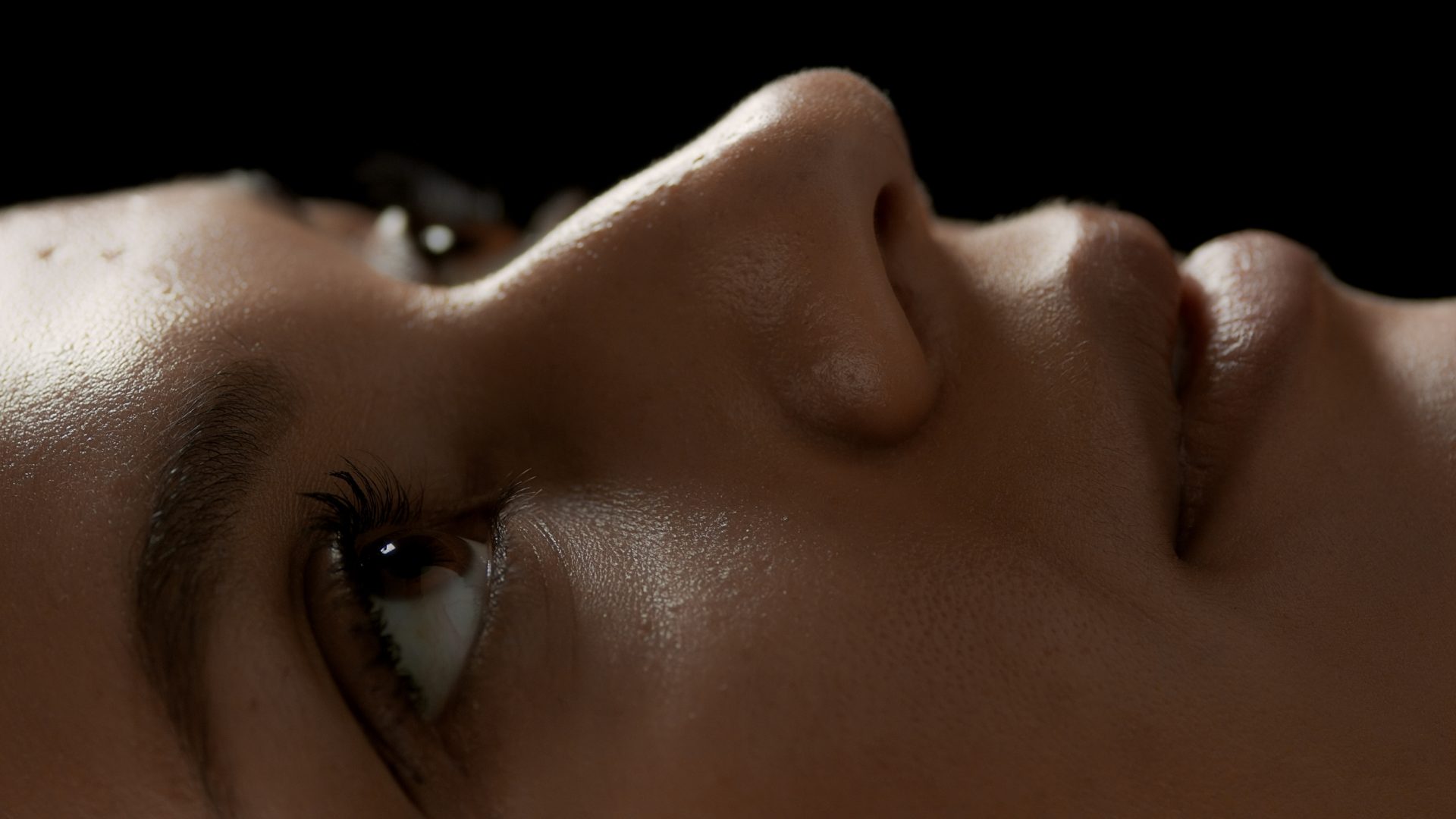Imagine waking up unable to smile, blink, or raise one eyebrow. Your face feels heavy, lopsided, perhaps even numb. Water dribbles from the corner of your mouth when you drink. This alarming experience describes Bell’s palsy, a temporary facial paralysis that affects thousands of Americans annually, striking suddenly and often without clear cause.
Recognizing the sudden paralysis
Bell’s palsy uniquely affects the muscles on one side of the face, creating a distinctive asymmetrical appearance. The condition results from inflammation of the seventh cranial nerve, which controls facial expressions and movements. This nerve swelling typically impacts only one of the two facial nerves, creating the characteristic one-sided drooping.
The onset of symptoms typically occurs rapidly, often developing overnight and reaching maximum severity within 48 to 72 hours. This sudden appearance contributes significantly to the alarming nature of the condition. Severity varies widely among patients, with some experiencing mild weakness while others develop complete facial paralysis on the affected side.
The visual changes prove most immediately noticeable, particularly the inability to create normal facial expressions. The forehead may appear smooth and unwrinkled on the affected side, the eye might remain open when attempting to blink, and the mouth may droop noticeably. Many patients describe difficulty performing simple actions like drinking without spillage, eating without food escaping, or pronouncing certain sounds clearly.
Beyond the obvious symptoms
While facial muscle paralysis represents the primary and most visible symptom, Bell’s palsy often includes several additional uncomfortable effects. Patients frequently report experiencing:
- Drooling due to weakened mouth muscles
- Persistent dry eye from incomplete blinking
- Pain behind the ear or in the face
- Changes in taste perception
- Increased sensitivity to sound
- Ringing in the ears
- Headaches
- Difficulty speaking clearly
Notably, while the face may feel numb or heavy, patients typically retain normal sensation to touch and temperature. This distinguishes Bell’s palsy from conditions involving sensory nerve damage. The paralysis affects movement capability without diminishing sensation.
Early warning signs sometimes precede full symptom development, though they often go unrecognized until after diagnosis. Some patients report mild fever or pain behind the ear shortly before facial symptoms appear. Unfortunately, these subtle indicators provide little actionable warning, as symptoms progress regardless of intervention once the inflammatory process begins.
Understanding the causes
The primary mechanism behind Bell’s palsy involves inflammation and compression of the facial nerve as it passes through a narrow bony canal in the skull. This swelling restricts the nerve’s function, preventing normal transmission of signals to facial muscles. However, what triggers this inflammation remains less clear in many cases.
Viral infections appear to play a significant role in many Bell’s palsy cases. Several viruses have demonstrated particular association with the condition, including herpes simplex type 1, varicella-zoster, Epstein-Barr, and more recently, COVID-19. These infections may trigger an inflammatory response affecting the facial nerve, though the exact mechanism remains incompletely understood.
Various factors potentially increase vulnerability to developing Bell’s palsy. People with diabetes face elevated risk, as do pregnant women, particularly those with preeclampsia. Other risk factors include obesity, hypertension, and having previously experienced Bell’s palsy. Immune system challenges from stress, illness, or sleep deprivation may also contribute to susceptibility.
Despite identified associations, healthcare providers cannot determine a specific trigger in most individual cases. This idiopathic nature, where causes remain unidentified, contributes to both patient frustration and continuing research interest in the condition.
Distinguishing from serious conditions
The symptoms of Bell’s palsy closely resemble those of more serious medical emergencies, particularly stroke. This similarity necessitates prompt medical evaluation for any sudden facial weakness or paralysis. Distinguishing between these conditions proves crucial for appropriate treatment and outcomes.
Stroke symptoms that overlap with Bell’s palsy include one-sided facial weakness, difficulty speaking, and muscle control loss. However, strokes typically present additional symptoms absent in Bell’s palsy, such as weakness in the arm or leg on the affected side, vision changes, coordination problems, dizziness, or severe headache. Unlike Bell’s palsy, which develops over hours, stroke symptoms often appear instantaneously.
Other conditions that can mimic Bell’s palsy include Lyme disease, sarcoidosis, middle ear infections, multiple sclerosis, and tumors near the facial nerve. While Bell’s palsy remains most common, healthcare providers must consider these alternatives during evaluation, particularly in cases with unusual presentations or additional symptoms.
Diagnosis process
Healthcare providers typically diagnose Bell’s palsy through a combination of medical history and physical examination. During examination, the provider will ask patients to perform various facial movements, such as raising eyebrows, closing eyes, smiling, and puffing cheeks. These actions help assess the extent and pattern of muscle weakness.
A key diagnostic finding involves weakness of the forehead. In central nervous system problems like stroke, forehead muscles often remain functional because they receive nerve signals from both sides of the brain. In Bell’s palsy, forehead muscles on the affected side typically show weakness, helping providers differentiate between possible causes.
While many cases receive diagnosis based solely on clinical examination, providers sometimes order additional tests to rule out alternative conditions or determine prognosis. These may include blood tests for conditions like Lyme disease, electrical tests to measure nerve function, imaging studies like MRI to examine brain and nerve structures, or in rare cases, lumbar puncture to analyze spinal fluid.
Treatment approaches
Most Bell’s palsy cases resolve without specific intervention, but several treatments may help relieve symptoms and potentially speed recovery. Current medical approaches focus on reducing inflammation, protecting vulnerable structures, and supporting natural healing processes.
Eye protection represents a critical treatment priority. The inability to close the affected eye completely leaves the cornea vulnerable to drying, irritation, and potential injury. Artificial tears during the day and lubricating ointments at night help maintain moisture. Some patients require eye patches or tape to keep the eye closed, particularly during sleep.
Oral corticosteroids, such as prednisone, provide the most established medical treatment. These medications reduce nerve inflammation and improve recovery outcomes, particularly when started within the first 48 hours of symptom onset. Research indicates patients receiving early corticosteroid treatment show better recovery rates than those without treatment.
Antiviral medications sometimes accompany corticosteroids, particularly in severe cases or when providers suspect herpes virus involvement. However, evidence supporting antiviral treatment remains less conclusive than for corticosteroids. Most providers reserve this approach for patients with complete paralysis or other concerning features.
Physical therapy techniques, including facial exercises and massage, may help maintain muscle tone during recovery. However, physicians typically recommend against electrical stimulation of facial muscles, as research has not demonstrated benefit and some studies suggest potential harm to recovering nerve fibers.
Recovery expectations
Recovery trajectories vary considerably among Bell’s palsy patients, though most experience positive outcomes. Approximately 80% of patients achieve complete recovery with no residual symptoms within three months. Improvement typically begins within three weeks of symptom onset, progressing gradually over several months.
For the remaining 20% of patients, some degree of permanent facial weakness may persist. Recovery chances decrease with age over 60, complete initial paralysis rather than partial weakness, and certain accompanying symptoms like decreased saliva production or taste alterations. Early treatment with corticosteroids significantly improves long-term outcomes for many patients.
Recurrence affects approximately 5% to 10% of Bell’s palsy patients, who may experience repeat episodes later in life. These subsequent episodes may affect either the same or opposite side of the face. Managing identified risk factors like diabetes or hypertension may potentially reduce recurrence likelihood, though evidence remains limited.
In cases with incomplete recovery, facial rehabilitation specialists can provide exercises to maximize function. For persistent eye closure problems or significant facial asymmetry affecting quality of life, surgical interventions offer potential improvement. These include procedures to improve eyelid closure or create better facial symmetry at rest and during expressions.
Living with Bell’s palsy
During recovery, several self-care approaches can help manage symptoms and support healing. Gentle massage of affected facial muscles may help maintain circulation and prevent muscle atrophy. Moist heat application sometimes provides pain relief. Patients should continue protecting the affected eye until blinking function normalizes.
Psychological impacts often prove significant, as facial appearance changes affect self-image and social interactions. Many patients benefit from connecting with support resources, including others who have experienced the condition. Understanding the typically temporary nature of symptoms helps maintain perspective during recovery.
Regular follow-up with healthcare providers ensures appropriate progress monitoring. If improvement stalls or new symptoms develop, additional evaluation may identify complications or alternative diagnoses requiring different treatment approaches. Patients should seek immediate medical attention for any worsening symptoms, particularly involving eye health or hearing changes.
Though Bell’s palsy cannot be prevented, maintaining general health through adequate sleep, stress management, and control of conditions like diabetes may potentially reduce risk. The sudden, mysterious nature of Bell’s palsy makes the experience particularly challenging, but knowledge about its typically favorable prognosis provides reassurance during the recovery journey.















